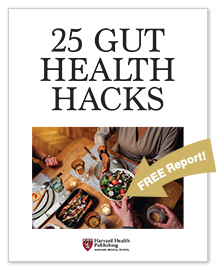
5 timeless habits for better health

What are the symptoms of prostate cancer?

Is your breakfast cereal healthy?

When pain signals an emergency: Symptoms you should never ignore

Does exercise give you energy?

Acupuncture for pain relief: How it works and what to expect

How to avoid jet lag: Tips for staying alert when you travel

Biofeedback therapy: How it works and how it can help relieve pain

Best vitamins and minerals for energy

Should you take probiotics with antibiotics?
Heart Disease Archive
Articles
Talk therapy for depression may help lower heart disease risk
For people with depression, successful treatment with talk therapy may lower the risk for heart disease, perhaps by helping them adopt healthier habits, according to a 2023 study.
Living longer, free of heart disease?
Lifestyle habits to prevent heart disease and strokes may also lower a person's risk for two other leading causes of death: cancer and dementia.
Exercise and your arteries
Regular exercise is crucial to keeping the circulatory system functioning optimally, which in turn is beneficial to overall health and protection from heart disease.
Checking for an abdominal aortic aneurysm: Who, when, and why?
Guidelines recommend that men ages 65 to 75 who have ever smoked cigarettes be screened for an abdominal aortic aneurysm (AAA). But other people at high risk might also consider this one-time test. These include older men and women with a family history of AAA and those with chronic obstructive pulmonary disease or atherosclerotic heart disease. The screening test is simple and painless, and it costs roughly $50, which is fully covered by Medicare for men who meet the guideline criteria, as well as for people ages 65 to 75 with a family history of AAA.
What causes a leaky mitral valve?
The mitral valve controls blood flow between the upper and lower chambers on the left side of the heart. Some people are born with a faulty mitral valve, which can cause blood to leak backward across the valve, a problem known as mitral regurgitation. But most people acquire mitral regurgitation in response to a different heart ailment, such as a heart attack, heart failure, or heart muscle disease. People with a moderate amount of mitral regurgitation should see their physician twice a year and get a yearly echocardiogram, or sooner if they develop symptoms. These include shortness of breath, fatigue, cough, palpitations, and swollen feet or ankles.
Getting to the heart of a fainting spell
Fainting happens when the brain isn't getting enough blood, which leads to a temporary loss of consciousness. Most of the time, fainting is benign and not the symptom of a serious underlying problem. In people who are otherwise healthy, fainting (what doctors call syncope) is rarely the first manifestation of a cardiovascular problem. However, people who already have heart problems are more prone to fainting than the average person.
When the heart "skips a beat," flip-flops, or flutters
Heart palpitations are defined as an awareness of a strong, rapid, or irregular heartbeat. They are among the most common reasons people consult general internists and cardiologists. Most brief rhythm disruptions are harmless, such as those caused by an earlier-than-usual contraction of the heart's upper chambers (atria) or lower chambers (ventricles). These are often perceived as either a skipped beat or a pounding or flip-flopping sensation. A fluttering sensation in the chest may suggest an unusually fast heart rate, which can result from an electrical misfire in the upper part of the heart and may require treatment.
Understanding blood thinners
Drugs that discourage blood clots (commonly called blood thinners) don't actually make the blood less viscous. The two main types of these drugs, anticoagulants and antiplatelet drugs, interfere with different blood components involved in clot formation. Anticoagulants treat blood clots in the legs and lungs and are also prescribed to people with atrial fibrillation. Antiplatelet drugs are used to prevent heart attacks and strokes and to treat people who receive stents.
Angioplasty and stenting through the arm
When doctors insert a stent into the heart's artery, they usually enter the body through an artery at the top of the thigh. But for some people, using a vessel in the arm may be a safer and less costly option.

5 timeless habits for better health

What are the symptoms of prostate cancer?

Is your breakfast cereal healthy?

When pain signals an emergency: Symptoms you should never ignore

Does exercise give you energy?

Acupuncture for pain relief: How it works and what to expect

How to avoid jet lag: Tips for staying alert when you travel

Biofeedback therapy: How it works and how it can help relieve pain

Best vitamins and minerals for energy

Should you take probiotics with antibiotics?
Free Healthbeat Signup
Get the latest in health news delivered to your inbox!
Sign Up











